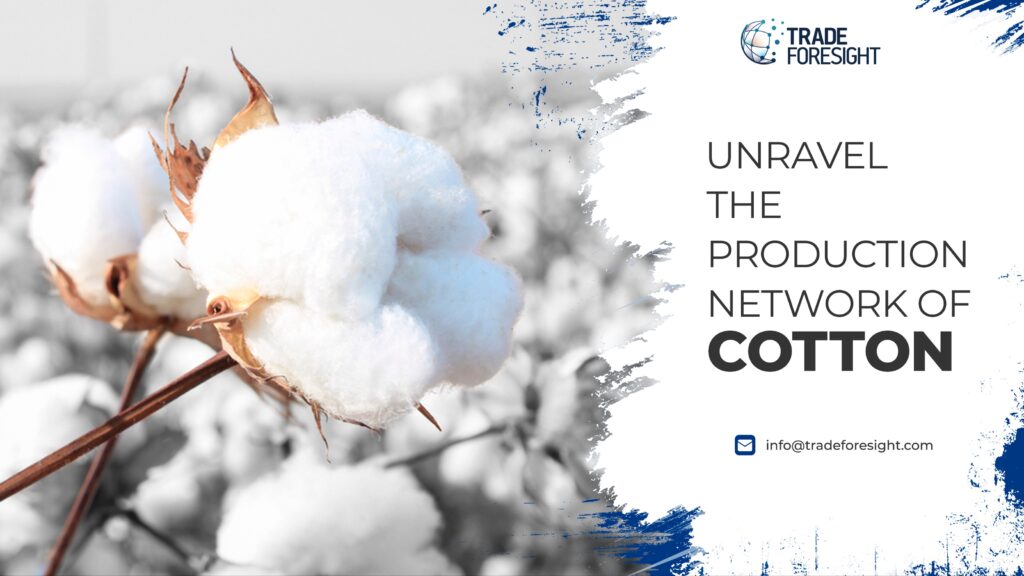
Unravel The Production Network of Cotton
Cotton is one of the world’s most widely grown and traded crops, with an annual global production of over 25 million tons. It is a highly versatile and valuable commodity that is used in a variety of industries, including textiles, paper, and food.
Cotton Import and Export Overview
Cotton is grown in over 80 countries around the world, with the largest producers being China, India, and the United States. These three countries account for over half of the world’s cotton production.
Cotton is also one of the most traded commodities globally, with an estimated annual trade value of around $50 billion. The top cotton importing countries are China, Bangladesh, Vietnam, Turkey, and Indonesia, while the top cotton exporting countries are the United States, India, Brazil, and Australia.
Cotton Import and Export Process
The cotton import and export process involves several stages, including cultivation, harvesting, ginning, baling, transportation, and marketing.
Cultivation: Cotton is grown in warm and humid climates, with planting typically taking place in the spring and early summer. The crop takes around five months to mature, and the plants must be irrigated and fertilized to ensure a healthy yield.
Harvesting:Once the cotton plants have matured, the bolls containing the cotton fibers are picked by hand or machine. Mechanical harvesting is more common in large-scale commercial farming operations, while handpicking is still prevalent in smaller-scale operations.
Ginning:After harvesting, the cotton fibers are separated from the seeds and other debris in a process called ginning. This process involves passing the cotton through machines that separate the fibers from the seeds and then clean and grade the fibers.
Baling:Once the cotton fibers have been ginned, they are compressed into bales for transportation. The bales are typically wrapped in protective covering to prevent damage and contamination.
Transportation: Cotton bales are transported by trucks, trains, ships, or airplanes to their final destination. Most cotton exports are transported by sea, with the major shipping routes connecting the major cotton producing and consuming countries.
Marketing: Cotton is sold through various channels, including futures markets, commodity brokers, and direct sales. The price of cotton is determined by supply and demand factors, including weather conditions, crop yields, and global trade policies.
Cotton Import and Export Trends
The cotton trade has been volatile in recent years, with fluctuations in global demand and supply affecting prices and trade volumes.
One of the most significant trends in cotton import and export is the shift in demand from developed to developing countries. In the past, the major cotton consuming countries were in the developed world, including the United States, Europe, and Japan. However, with the rise of the textile industry in developing countries, such as China, India, and Bangladesh, the demand for cotton has shifted to these countries.
Another trend in cotton import and export is the increasing focus on sustainability and ethical sourcing. Consumers are becoming more aware of the environmental and social impact of cotton production and are demanding more transparency and accountability from cotton producers and suppliers. This has led to the development of various certification programs, such as the Better Cotton Initiative and Fairtrade, which promote sustainable and ethical cotton production practices.
Cotton Import and Export Challenges
The cotton trade faces several challenges, including price volatility, climate change, and political instability.
- Price volatility is a significant challenge for cotton producers and traders, with fluctuations in global demand and supply affecting prices and trade volumes. This can result in reduced income for farmers and increased costs for traders, leading to financial instability.
- Climate change is also a significant challenge for cotton production, with rising temperatures, drought, and extreme weather events affecting crop yields and quality. This can lead to reduced production and increased costs for farmers, as well as supply disruptions for traders and consumers.
- Political instability is another significant challenge for cotton import and export, with trade policies and regulations changing rapidly in response to political developments. For example, trade disputes between major cotton producing and consuming countries, such as the United States and China, can lead to tariffs and other trade restrictions that can significantly impact the cotton trade.
- In addition, political instability in cotton producing countries can lead to disruptions in production and supply chains, which can have a significant impact on global cotton prices and trade volumes.
Conclusion
Cotton is a valuable and versatile commodity that is widely traded around the world. The cotton import and export process involves several stages, including cultivation, harvesting, ginning, baling, transportation, and marketing. The cotton trade faces several challenges, including price volatility, climate change, and political instability. However, with the increasing focus on sustainability and ethical sourcing, there are also opportunities for the cotton industry to adopt more responsible and transparent practices.

